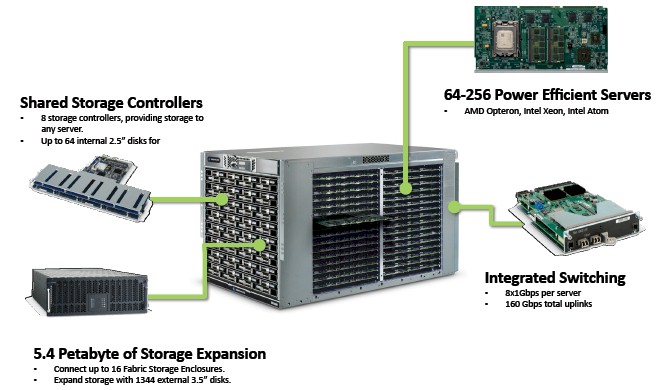AMD, Canonical Do OpenStack In A Box

The developers behind OpenStack have come a long way in adding fit and finish to successive releases of the cloud controller, but it is still a pain in the neck to build a cluster and install OpenStack on it to create a cloud. Chip and server maker AMD is working with commercial Linux and OpenStack distributor Canonical to make this process a whole lot easier.
The two have done the integration work to put Canonical's implementation of OpenStack, which is bundled in Ubuntu Server LTS 14.04, which shipped this past spread, on AMD's SeaMicro 15000 microservers. The SeaMicro machine includes virtual compute, networking, and storage all inside of a single enclosure, and this radically simplifies the hardware configuration and software setup process.
The SeaMicro 15000 servers, launched two years ago, are the latest generation of microservers from AMD, and they are based on a design philosophy that SeaMicro came up with many years ago when it pioneered the microserver idea. The SeaMicro processor cards use a set of dual PCI-Express mechanical ports to link server nodes into the midplane of the chassis. The heart of the system is a custom 3D torus interconnect, called the Freedom Fabric, which has 1.28 Tb/sec of bandwidth and which hooks the compute nodes to each other, to storage inside the chassis and hanging off it through external disk enclosures, and to Ethernet ports that link to the outside world.
The heftier SeaMicro compute nodes have one "Haswell" Xeon E3-1265L v3 processor, which has four cores, or one "Piledriver" custom Opteron chip, which goes by the name EE-4365 (although we are not supposed to know that) and which has eight cores. The Xeon E3 v3 node can support a maximum of 32 GB, but the Opteron node can double that up to 64 GB. Either way, it works out to a maximum of 8 GB per core, which is plenty of memory for a lot of cloudy workloads. The SeaMicro enclosure has room for 64 Xeon or Opteron compute nodes and 64 2.5-inch disk drives. The SM15000 can have up to sixteen external disk enclosures, each holding 84 disk drives. That works out to a maximum of 5.37 PB of capacity for a single 64-node microserver cluster. The Freedom Fabric has enough oomph to deliver 10 Gb/sec of bandwidth (over ten virtual links with each having 1 Gb/sec) per socket and has sixteen 10 Gb/sec uplinks out of the chassis.
Back in June, after the OpenStack Summit, AMD and Canonical worked together to run some benchmarks on the combination of Ubuntu Server/OpenStack on the SeaMicro iron to show how quickly it could fire up virtual machines on OpenStack. They dedicated nine enclosures with a total of 576 nodes to the benchmark test. It took 6.5 hours to get 75,000 VMs running across 320 nodes, and eleven hours to push that up to 100,000 VMs across 380 nodes. The full setup of 576 nodes could handle 168,000 VMs, but neither AMD nor Canonical would say how long it took to fire them all up, but it looks like it would take about a day.
Having proved the scalability and performance of OpenStack on the SeaMicro SM15000 iron, now the two companies are offering a preconfigured OpenStack setup. Rather than bundle the Ubuntu Server and OpenStack software directly on the SeaMicro iron, explains Young-Sae Song, corporate vice president of marketing for datacenter solutions at AMD, the companies have worked to tweak OpenStack to run well on the Freedom fabric and have also created so-called "charms" for the Juju service orchestration tool that Canonical has added to Ubuntu Server and OpenStack to completely automate the deployment of the software. Juju can automate the installation of Ubuntu Server across the Amazon Web Services EC2, Microsoft Azure, and Hewlett-Packard Helion. (Charms are akin to recipes in Chef, if you want to extend a metaphor.) The benefit of partnering with Canonical is that the freebie versions of Ubuntu Server and its OpenStack are the same versions that can have support contracts; this is not the case with the freebie CentOS and the commercially supported Red Hat Enterprise Linux.
At the moment, AMD is only looking at OpenStack as the cloud controller of choice, and is not considering other open source cloud controllers such Eucalyptus (which was just acquired by Hewlett-Packard last week) or CloudStack (controlled by Citrix Systems after is acquired it a few years back). "We think that OpenStack is going to be the big winner," says Song. "While we have some customers using CloudStack, all of the interest we are seeing now is for OpenStack."
The base SeaMicro OpenStack setup uses the Metal-As-A-Service bare metal configuration tool from Canonical to lay down hypervisors on the nodes. A single enclosure has three Nova controller nodes and 57 Nova compute nodes, plus three Cinder storage controller nodes that reach into the SM15000 disk bays and convert them to block storage. AMD and Canonical reckon that a single SM15000 can support 3,500 "tiny" VM instances, which have one virtual CPU and 1 GB of virtual memory allocated to them up to 150 "xlarge" VM instances with 8 vCPUs and 16 GB of vRAM each. Using the Opteron processors and configuring each node with 64 GB of memory and with sixteen base 500 GB disks in the chassis and half of the system I/O turned on in a single enclosure, AMD reckons the SeaMicro machine burns 3.3 kilowatts, or about 55 watts per node.
As part of the agreement between AMD and Canonical, AMD will be reselling support services for Ubuntu Server and its integrated OpenStack. Song says that AMD is looking at doing similar reference architectures for other OpenStack distros, and significantly, Red Hat has deployed its own OpenStack and its own OpenShift platform cloud atop SeaMicro iron. So it is not hard to figure where AMD will go next.











